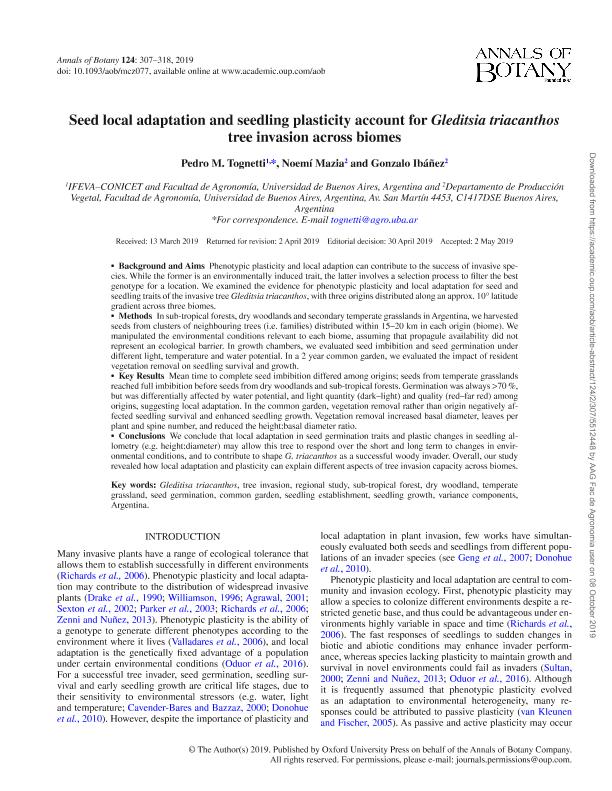Mostrar el registro sencillo del ítem
dc.contributor.author
Tognetti, Pedro Maximiliano

dc.contributor.author
Mazía, Cristina Noemí

dc.contributor.author
Ibáñez, Gonzalo
dc.date.available
2021-08-25T01:08:23Z
dc.date.issued
2019-07
dc.identifier.citation
Tognetti, Pedro Maximiliano; Mazía, Cristina Noemí; Ibáñez, Gonzalo; Seed local adaptation and seedling plasticity account for Gleditsia triacanthos tree invasion across biomes; Oxford University Press; Annals of Botany; 124; 2; 7-2019; 307-318
dc.identifier.issn
0305-7364
dc.identifier.uri
http://hdl.handle.net/11336/138827
dc.description.abstract
Background and Aims: Phenotypic plasticity and local adaption can contribute to the success of invasive species. While the former is an environmentally induced trait, the latter involves a selection process to filter the best genotype for a location. We examined the evidence for phenotypic plasticity and local adaptation for seed and seedling traits of the invasive tree Gleditsia triacanthos, with three origins distributed along an approx. 10° latitude gradient across three biomes. Methods: In sub-tropical forests, dry woodlands and secondary temperate grasslands in Argentina, we harvested seeds from clusters of neighbouring trees (i.e. families) distributed within 15-20 km in each origin (biome). We manipulated the environmental conditions relevant to each biome, assuming that propagule availability did not represent an ecological barrier. In growth chambers, we evaluated seed imbibition and seed germination under different light, temperature and water potential. In a 2 year common garden, we evaluated the impact of resident vegetation removal on seedling survival and growth. Key Results: Mean time to complete seed imbibition differed among origins; seeds from temperate grasslands reached full imbibition before seeds from dry woodlands and sub-tropical forests. Germination was always >70 %, but was differentially affected by water potential, and light quantity (dark-light) and quality (red-far red) among origins, suggesting local adaptation. In the common garden, vegetation removal rather than origin negatively affected seedling survival and enhanced seedling growth. Vegetation removal increased basal diameter, leaves per plant and spine number, and reduced the height:basal diameter ratio. Conclusions: We conclude that local adaptation in seed germination traits and plastic changes in seedling allometry (e.g. height:diameter) may allow this tree to respond over the short and long term to changes in environmental conditions, and to contribute to shape G. triacanthos as a successful woody invader. Overall, our study revealed how local adaptation and plasticity can explain different aspects of tree invasion capacity across biomes.
dc.format
application/pdf
dc.language.iso
eng
dc.publisher
Oxford University Press

dc.rights
info:eu-repo/semantics/openAccess
dc.rights.uri
https://creativecommons.org/licenses/by-nc-sa/2.5/ar/
dc.subject
ARGENTINA
dc.subject
COMMON GARDEN
dc.subject
DRY WOODLAND
dc.subject
GLEDITISA TRIACANTHOS
dc.subject
REGIONAL STUDY
dc.subject
SEED GERMINATION
dc.subject
SEEDLING ESTABLISHMENT
dc.subject
SEEDLING GROWTH
dc.subject
SUB-TROPICAL FOREST
dc.subject
TEMPERATE GRASSLAND
dc.subject
TREE INVASION
dc.subject
VARIANCE COMPONENTS
dc.subject.classification
Ecología

dc.subject.classification
Ciencias Biológicas

dc.subject.classification
CIENCIAS NATURALES Y EXACTAS

dc.subject.classification
Otras Ciencias Agrícolas

dc.subject.classification
Otras Ciencias Agrícolas

dc.subject.classification
CIENCIAS AGRÍCOLAS

dc.subject.classification
Ciencias de las Plantas, Botánica

dc.subject.classification
Ciencias Biológicas

dc.subject.classification
CIENCIAS NATURALES Y EXACTAS

dc.title
Seed local adaptation and seedling plasticity account for Gleditsia triacanthos tree invasion across biomes
dc.type
info:eu-repo/semantics/article
dc.type
info:ar-repo/semantics/artículo
dc.type
info:eu-repo/semantics/publishedVersion
dc.date.updated
2020-12-15T14:16:33Z
dc.journal.volume
124
dc.journal.number
2
dc.journal.pagination
307-318
dc.journal.pais
Reino Unido

dc.journal.ciudad
Oxford
dc.description.fil
Fil: Tognetti, Pedro Maximiliano. Consejo Nacional de Investigaciones Científicas y Técnicas. Oficina de Coordinación Administrativa Parque Centenario. Instituto de Investigaciones Fisiológicas y Ecológicas Vinculadas a la Agricultura. Universidad de Buenos Aires. Facultad de Agronomía. Instituto de Investigaciones Fisiológicas y Ecológicas Vinculadas a la Agricultura; Argentina. Universidad de Buenos Aires. Facultad de Agronomía. Departamento de Métodos Cuantitativos y Sistemas de Información; Argentina
dc.description.fil
Fil: Mazía, Cristina Noemí. Universidad de Buenos Aires. Facultad de Agronomía. Departamento de Producción Vegetal; Argentina
dc.description.fil
Fil: Ibáñez, Gonzalo. Universidad de Buenos Aires. Facultad de Agronomía. Departamento de Producción Vegetal; Argentina
dc.journal.title
Annals of Botany

dc.relation.alternativeid
info:eu-repo/semantics/altIdentifier/url/https://academic.oup.com/aob/article-abstract/124/2/307/5512448
dc.relation.alternativeid
info:eu-repo/semantics/altIdentifier/doi/http://dx.doi.org/10.1093/aob/mcz077
Archivos asociados
